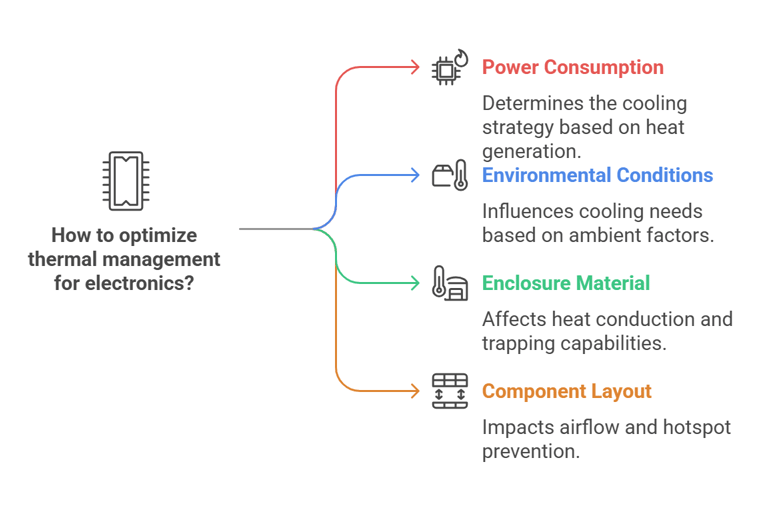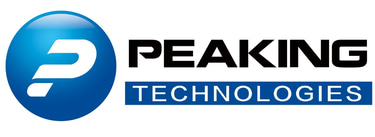Thermal Management in Electronic Enclosure Design: Keeping Your Gadgets Cool and Reliable
We’ve all been there: your smartphone feels like a frying pan after a video call, or your laptop fan starts whirring like a jet engine during a presentation. These everyday annoyances are more than just inconveniences—they’re red flags for poor thermal management. In the world of electronics, heat is the silent killer.
2/7/20254 min read


We’ve all been there: your smartphone feels like a frying pan after a video call, or your laptop fan starts whirring like a jet engine during a presentation. These everyday annoyances are more than just inconveniences—they’re red flags for poor thermal management. In the world of electronics, heat is the silent killer. Without proper cooling, even the most advanced devices can fail prematurely, overheat, or worse, become safety hazards.
In this article, we’ll dive into the art and science of thermal management in electronic enclosures. Whether you’re designing a sleek wearable or a rugged industrial control panel, these tips and tricks will help you balance performance, safety, and user experience.
Why Should You Care About Thermal Management?
Imagine running a marathon in a winter coat—your body would overheat, sweat excessively, and eventually shut down. Electronics aren’t much different. Components like processors, power supplies, and batteries generate heat as they work, and without a way to dissipate that energy, your device could suffer:
Component Failure: Overheating can warp circuit boards, melt solder joints, or fry sensitive chips.
Reduced Lifespan: Continuous exposure to high temperatures ages components faster, like leaving a car engine running nonstop.
Safety Risks: In extreme cases, overheating can lead to fires, especially in high-power systems like EV batteries or servers.
On the flip side, good thermal management isn’t just about avoiding disasters. It ensures your device runs smoothly, complies with safety certifications (like UL or CE), and delivers a seamless user experience. Let’s explore how to achieve this.


The Four Pillars of Thermal Management
Designing an enclosure that keeps electronics cool isn’t just about slapping on a fan. It’s a balancing act influenced by four key factors:
Power Consumption
High-performance devices, like gaming PCs or industrial robots, generate more heat. A device drawing 100W needs a vastly different cooling strategy than a 10W IoT sensor.Environmental Conditions
Is your device sitting in an air-conditioned office or braving the Arizona desert? Ambient temperature, humidity, and exposure to elements dictate whether you need basic vents or a hermetically sealed liquid-cooled system.Enclosure Material
Metal (Aluminum/Steel): Conducts heat away naturally—great for passive cooling.
Plastic: Lightweight and affordable, but traps heat. You’ll need fans or heat sinks to compensate.
Component Layout
Cramming components together is like stuffing a closet—heat gets trapped. Smart spacing and arrangement promote airflow and prevent hotspots.
Cooling Techniques: Passive vs. Active
Passive Cooling: Let Physics Do the Work
Passive cooling relies on natural heat dissipation—no moving parts, no noise, and minimal maintenance.
Material Choice: Aluminum enclosures act like giant heat sinks, silently wicking heat away. Apple’s MacBooks use this approach for slim, fanless designs.
Ventilation: Strategic perforations or vents (think gaming consoles) allow hot air to rise and escape.
Heat Sinks: Attach these finned metal pieces to hot components (like CPUs) to increase surface area for heat dissipation.
Pro Tip: Thermal interface materials (TIMs), like pastes or pads, bridge microscopic gaps between components and heat sinks, boosting efficiency by up to 30%.
Active Cooling: When You Need Muscle
For high-power systems, passive methods aren’t enough. Enter active cooling:
Fans: The go-to solution for PCs and servers. Place intake fans at the bottom/front and exhaust fans at the top/back to leverage natural convection.
Liquid Cooling: Used in supercomputers and EVs, liquid cooling circulates coolant through pipes, absorbing heat far more efficiently than air.
Trade-Off Alert: Active systems add cost, noise, and complexity. A drone’s flight controller might skip fans to save weight, but a data center server can’t.
Designing for Efficiency: From Concept to Prototype
Optimize Layout and Spacing
Arrange components like a city planner—keep heat-generating parts (power supplies, motors) separate from sensitive ones (sensors, batteries). Leave room for airflow corridors.Simulate Before You Build
Computational Fluid Dynamics (CFD) software, like ANSYS or SolidWorks Flow Simulation, lets you visualize heat flow and test “what-if” scenarios digitally. Spot hotspots before prototyping!Protect Against the Elements
Outdoor Enclosures: Use reflective coatings to repel sunlight and sealed vents with breathable membranes (e.g., Gore-Tex) to block rain while allowing airflow.
Dusty Environments: Add removable filters to fan intakes, but remember to clean them—clogged filters are worse than none.
Balancing Act: Thermal vs. Other Priorities
Aesthetics vs. Functionality
Consumer gadgets need to look good. Hide vents under bezels or use decorative patterns that double as airflow channels. Gaming PCs turn cooling into a feature with RGB-lit fans.Waterproofing vs. Ventilation
IP-rated enclosures can’t have gaping holes, but labyrinthine vents or hydrophobic meshes allow airflow while repelling water.Cost vs. Performance
A 20thermalcameramightgetbywithpassivecooling,buta20thermalcameramightgetbywithpassivecooling,buta20,000 MRI machine needs liquid nitrogen. Match the solution to the device’s value and lifespan.
Real-World Wins in Thermal Management
Handheld Medical Device
A portable ultrasound scanner used an aluminum casing with internal heat sinks, avoiding fans that could harbor germs in hospitals.High-Performance Desktop
By placing dual exhaust fans near the GPU and CPU, a gaming PC manufacturer reduced internal temps by 15°C without increasing noise.Data Center Server Rack
A “front-to-back” airflow design, paired with variable-speed fans, cut cooling costs by 20% in a server farm, proving that smart layout pays off.
Working with Manufacturers: Collaboration is Key
Don’t go it alone! When partnering with manufacturers:
Share detailed specs (power use, max ambient temperature).
Ask for material samples—sometimes a composite blends conductivity and cost better than pure aluminum.
Demand prototypes for real-world testing. A 3D-printed model can reveal airflow issues no simulation catches.
Final Thoughts: Don’t Let Your Design Go Up in Smoke
Thermal management isn’t an afterthought—it’s a cornerstone of reliable design. By prioritizing heat dissipation early, you’ll avoid costly redesigns, recalls, or worse, a product that flames out (literally).
Whether you’re building a smartwatch or a satellite, remember: Cool gadgets are happy gadgets.
Need Help Keeping Your Project Cool?
At Peakingtech, we specialize in custom enclosure designs that marry form, function, and thermal efficiency. Got a tricky cooling challenge? [Reach out to our team]—we’re here to turn your overheating headache into a cool, quiet success.
What’s the most creative cooling solution you’ve seen? Share your stories in the comments!
